Ukraine Today
Watch and Read about Ukraine Today

Ukraine information
Street view of Ukrainian cities on Google
Chersonesos – a Silent Trace of Ancient Ages
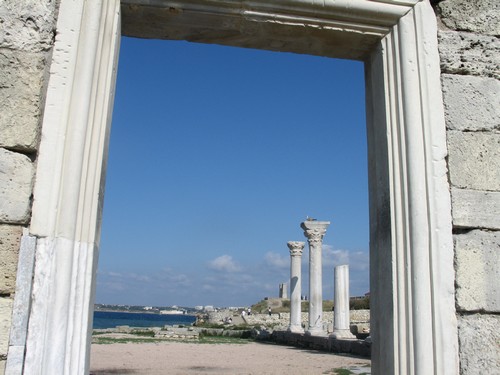 If you want to see and touch the beauty of ancient Greek, Roman and Byzantium cultures, you don’t need to go to Greece, Italy or Turkey. You can find it here on the West Crimean coast of Ukraine.
If you want to see and touch the beauty of ancient Greek, Roman and Byzantium cultures, you don’t need to go to Greece, Italy or Turkey. You can find it here on the West Crimean coast of Ukraine.
When you first come to the city of Sevastopol it might seem hard to believe that somewhere in this modern city is hidden a unique treasure of ancient history. But you’ll believe it indeed when you visit Chersonesos – the city’s open–air museum.
The city of Chersonesos was founded by Greeks at the end of the 5th Century B.C. and existed for two thousand years. The Greek word “chersonesos” means peninsula. And this name is fitting, because the city is situated on an 89-acre cape between two bays: Karantinnaya and Pesochnaya. In this place Nature created 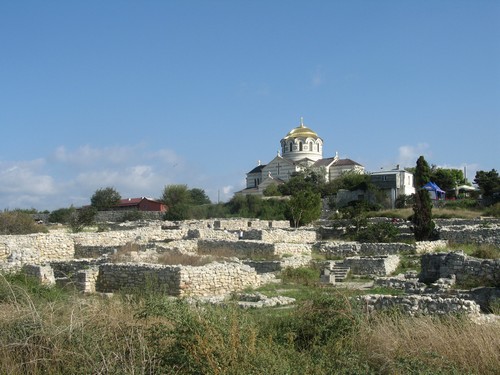 almost ideal conditions for a military harbor and a successful, prospering sea trade. As a result, during the 4th and 3rd Centuries B.C., this city state became a large center of local trade and controlled a large portion of West Crimea.
almost ideal conditions for a military harbor and a successful, prospering sea trade. As a result, during the 4th and 3rd Centuries B.C., this city state became a large center of local trade and controlled a large portion of West Crimea.
As you approach Chersonesos, the first thing that strikes your eyes is grandiose ruins of the city fortifications. In the 5th and 4th Centuries B.C. the city was surrounded by a short wall, which was replaced and enlarged at the beginning of the 3rd Century. After that renovation, the fortification stretched for more than two miles with a height of up to 33 feet and a thickness of between 11 and 13 feet. The whole area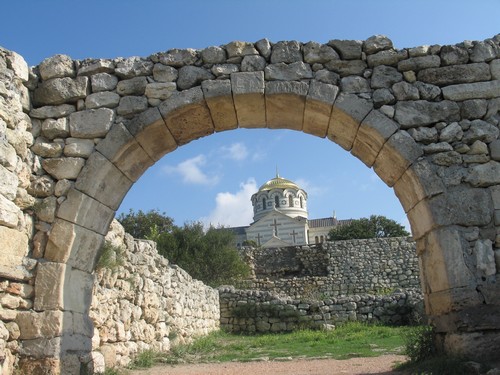 protected behind those walls was more than 74 acres.
protected behind those walls was more than 74 acres.
A short distance past the gate, you will find picturesque ruins of an ancient amphitheater. It was built in the 3rd Century B.C. and could seat approximately 2,000 people. The theater existed for a centuries and was reconstructed numerous times over the years, changing its appearance according to the epoch, tastes and regime in power. At first it was a classical Greek theater, where the audience would gathered in the morning and performances would take place until late in the evening (sometimes they lasted for several days).
Festively dressed people would come with food and comfortable rugs to cover the stone benches. They watched 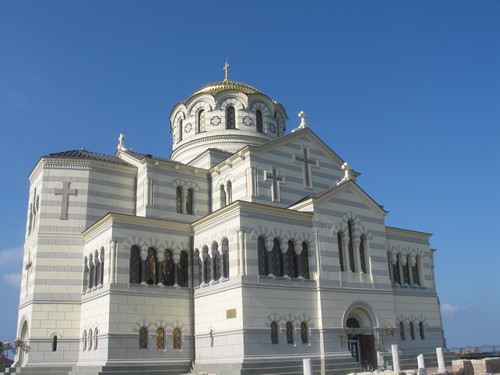 Greek comedies and tragedies accompanied by a choir. By the end of the 2nd Century B.C., violent wars with local tribes of Crimean Scythians caused the theater to be abandoned; some houses were even built on the site of the abandoned amphitheatre. In the 1st Century B.C. Chersonesos came under Roman control. At the end of the 2nd Century A.D. the theater was reconstructed to Roman style and performances resumed. It was the time of gladiatorial fights and bloody games with wild animals.
Greek comedies and tragedies accompanied by a choir. By the end of the 2nd Century B.C., violent wars with local tribes of Crimean Scythians caused the theater to be abandoned; some houses were even built on the site of the abandoned amphitheatre. In the 1st Century B.C. Chersonesos came under Roman control. At the end of the 2nd Century A.D. the theater was reconstructed to Roman style and performances resumed. It was the time of gladiatorial fights and bloody games with wild animals.
After 395 A.D. the city became a Byzantine possession. Because Christian moralities were incompatible with mass blood-shedding for fun, the theater was closed and ceased to exist. It fell into disrepair and even became the city’s garbage dump for a while. Later, people started to build private houses on the site and used stones from the theater as construction material. During the 10th and 11th Centuries A.D., the “Temple With the Reliquary” was built on the site, ruins of which are still standing over the theater’s left side.
After exploring the theater, you can climb a small hill covered with a cypress grove, which will lead you into a shady yard with a fountain in the middle. This area is known as the Greek Yard. The buildings around it are museums devoted to the antique and medieval times in the history of Chersonesos. Here you will find collections of the unique archeological finds discovered during almost 200 years of excavations.
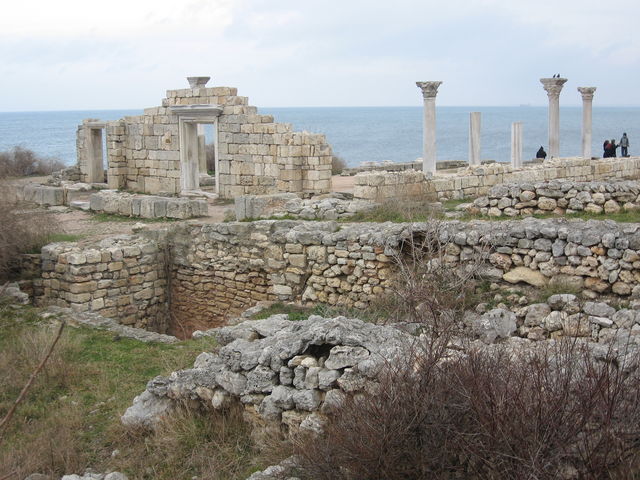
On a beautiful day, it is so tempting to sit down on one of the benches in the shadow, relax for a bit, and imagine how Chersonesos must have been looked thousands of years ago. But if you look around more thoroughly, you will notice a many pillars standing around the yard perimeter as if supporting the vault of heaven. These were brought here from Chersonesos’ medieval Christian temple by archeologists. But time passes quickly, and there are still many things to see in this ancient place. So, get up from your rest and let’s go to make new discoveries!
While descriptions and photographs can give you a small taste of Chersonesos, it really is a place that can only be appreciated properly in person. So, when will you come to Chersonesos? Article written by Oleg lavrentyev



